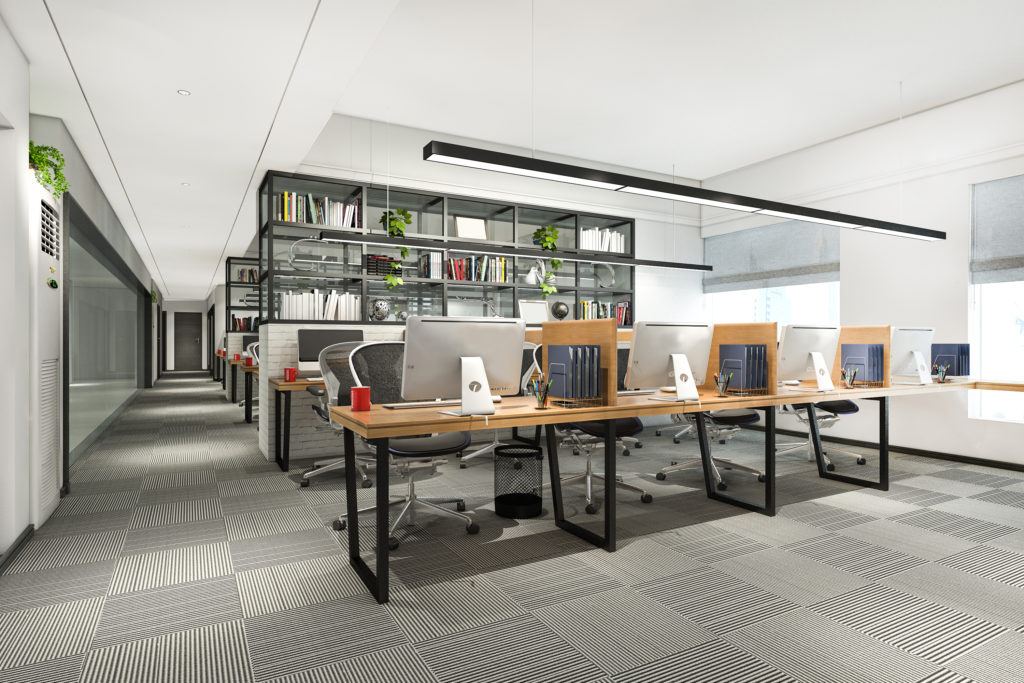The cleanliness of your commercial building sets the tone for shaping perceptions of customers and visitors and ensuring the health and productivity of everyone within. A meticulously maintained space signals professionalism, attention to detail, and a commitment to health and safety. Beyond aesthetics, a clean break room and office spaces will boost employee morale and productivity This comprehensive guide from the experts at HammondKnoll offers 20 essential cleaning tips to help commercial building managers create and maintain a space that leaves a lasting good impression.
Enhancing Air Quality and Comfort
1. Regular Air Filter Replacement
Air filters are the first line of defense against external pollutants. Over time, they accumulate allergens, dirt, dust, and potentially mildew, affecting indoor air quality and HVAC efficiency. Neglected filters can exacerbate allergies, leading to increased absenteeism and higher operational costs due to strained HVAC systems. Have your HVAC system professionally cleaned and its filters replaced on a regular schedule to make your commercial building a healthier environment for occupants and visitors alike.
Upholding Carpet Integrity
2. Scheduled Carpet Cleaning
Carpets act as a secondary filter, trapping dust, allergens, and dirt. Without regular cleaning, carpets can become a source of airborne contaminants and wear prematurely. High-traffic areas may require monthly maintenance, using thermal extraction methods recommended by manufacturers, to remove deeply embedded dirt. Less frequented spaces, like the top floors of buildings or unused offices, should still be cleaned annually to address accumulated pollutants. Calling in carpet maintenance companies such as HammondKnoll that specialize in commercial cleaning services ensures that your carpets remain in top condition, contributing to a cleaner, more inviting space.
Safeguarding Outdoor Spaces
3. Keep Your Outdoor Spaces Safe
Outdoor areas are susceptible to becoming slippery hazards, especially in shaded or damp conditions. The safety and cleanliness of outdoor areas reflect your commitment to overall building maintenance. Establishing a maintenance plan that includes regular sweeping, hosing, and the use of environmentally friendly cleaning products can significantly enhance the exterior appeal of your commercial building..
Addressing Specialized Cleaning Needs
4. How to Remove Glue from Carpets Effectively
Accidental glue spills require immediate attention to prevent permanent carpet damage. Use a systematic approach of scraping off excess glue, applying a detergent solution, and then an ammonia solution can effectively remove glue without harming the carpet fibers. Use these techniques and cleaning supplies right away after glue spills to ensure the carpet gets clean with no further damage. For costly oriental rugs, consider calling in a professional rug cleaning service for best results.
5. Managing “Moments of Truth” & Creating Positive Experiences
Every interaction or observation within your business is a critical touchpoint that contributes to the overall customer experience. These “moments of truth” shape perceptions of your business, and are significantly influenced by cleanliness. Neglected areas, whether it’s an unkempt reception area or poorly maintained restrooms, can damage customer perception and trust. A maintenance plan focused on regular cleaning and disinfecting of touched surfaces ensures every encounter within your facility contributes positively to your reputation.
6. Preventing Rust Stains
Rust stains and damage from improperly placed furniture can mar the appearance of carpets and are challenging to remove. To prevent these stains, professional commercial cleaning companies like HammondKnoll suggest you avoid placing furniture on damp carpets. If immediate placement is necessary, use protective barriers like foil under furniture legs to prevent direct contact and potential staining.
7. Rug-on-Carpet Protection
Placing rugs on carpets without proper protection can lead to damage. Professional maintenance services recommend using specialized pads to prevent slipping and wear, preserving the integrity and appearance of your flooring
Pay Attention to Floor and Surface Aesthetics
8. Keeping Office Floors Shiny
A gleaming floor enhances the overall ambiance of a workspace. Achieving a high shine on floors requires the right cleaning supplies and methods. Avoid using soaps or sponge mops that leave a dulling residue on tile or stone floors. Professional janitorial services use microfiber mops and non-filming cleaners to achieve a spotless shine without compromising the floor’s integrity.
Promoting Organizational Efficiency
9. Workspace Organization
A cluttered workspace hinders productivity and creates a negative impression. Implementing daily organizational practices not only streamlines operations but also enhances the professional image of your business. Professional commercial cleaning tips include daily decluttering and the use of disinfectant wipes on high-touch areas to maintain a clean and orderly environment.
Preserving Wood Flooring
10. Addressing Hardwood Floor Gaps
Hardwood floors are susceptible to seasonal changes, leading to gaps that can affect their appearance and performance. Monitoring and addressing these gaps promptly ensures the longevity of the flooring and maintains its aesthetic appeal. For gaps larger than ¼ inch, you may need to consult with a professional to prevent long-term damage.
Making Informed Carpet Choices
11. Choosing Durable Carpet Fibers
The right carpet fiber selection can significantly impact maintenance costs and longevity. Nylon, known for its durability and ease of cleaning, is ideal for high-traffic office environments. Making an informed choice based on traffic and use can prevent premature wear and reduce long-term costs associated with cleaning and replacement.
Creating Positive First Impressions
12. Enhancing First Impressions
The cleanliness of entrance areas and public spaces directly influences customer perceptions. Regular maintenance of these areas, including walk-off mats and flooring, is crucial in signaling a commitment to quality and care. A well-maintained entrance sets a positive tone for the entire customer experience..
Ensuring Health and Hygiene
13. Controlling Germs
Maintaining a hygienic workplace is vital for preventing the spread of illness. Strategic placement of hand sanitizers, regular disinfection of high-touch areas, and encouraging healthy practices among employees can significantly reduce the transmission of germs, contributing to a healthier, more productive work environment.
Caring for Furniture
14. Leather Furniture Maintenance
Leather furniture adds a touch of elegance but requires careful maintenance to prevent damage from spills and moisture. Prompt drying and application of leather conditioner can restore the natural oils lost due to moisture exposure, preserving the furniture’s beauty and durability. Shabby leather furniture reflects poorly on your space, so don’t hesitate to call in an expert for leather upholstery repair if needed.
Selecting the Right Decor
15. Selecting Appropriate Area Rugs
Choosing the right area rug can enhance the office’s aesthetic while protecting underlying carpets. Wool rugs are recommended for their natural stain resistance and durability, making them suitable for high-traffic areas. Proper selection ensures long-term beauty and functionality of both the rug and the carpet beneath.
Keeping the Office Customer-Ready
16. Ensuring Customer-Ready Offices
A clean and well-maintained office is inviting to customers and reflects positively on the business. Regular cleaning and attention to detail, from spotless floors to gleaming windows, demonstrate professionalism and pride in your business environment.
Luxury Vinyl Tile Flooring Care
17. Luxury Vinyl Tile Floor Care
LVT flooring offers a durable and attractive option for office spaces but requires proper maintenance to keep it looking its best. Regular cleaning with suitable products prevents dirt accumulation and maintains the floor’s aesthetic appeal.
Expert Stain Removal
18. Removing Sticky Spills From Carpets
Quickly addressing sticky spills like candy ensures carpets remain clean and presentable. A careful approach using gentle scraping and specific cleaning solutions can remove stains without damaging the carpet fibers.
Rug Maintenance Strategies
19. Fixing Ragged Rug Edges
Maintaining the edges of rugs can significantly extend their life and maintain a professional appearance. Professional edging services can repair worn or frayed edges, allowing rugs to continue protecting floors and enhancing decor.
Surface Cleaning Excellence
20. Choosing the Right Scrubber
Using the correct scrubbing pad prevents surface damage and ensures effective cleaning. Matching the pad’s abrasiveness to the surface type maintains cleanliness without compromising the material’s integrity.
Closing Thoughts
Adopting these 20 commercial cleaning strategies into your facility management practices can transform your commercial building, business, or office space into a model of cleanliness and efficiency. Regular maintenance, strategic planning, and attention to detail in your commercial cleaning practices will enhance your business’s image, employee satisfaction, and customer experience. A commitment to a clean, well-maintained environment will pay dividends in professionalism, health, and overall business success.
About HammondKnoll
At HammondKnoll, our mission is to provide top-tier commercial cleaning services that reflect our commitment to excellence. With extensive experience, a team of certified professionals, and a focus on customer satisfaction, we tailor our cleaning solutions to meet the unique needs of your business. Our comprehensive approach encompasses all the strategies discussed, ensuring your workspace is not only visually appealing but also a beacon of health and efficiency. Choose HammondKnoll as your trusted partner in maintaining a pristine, productive business environment.

